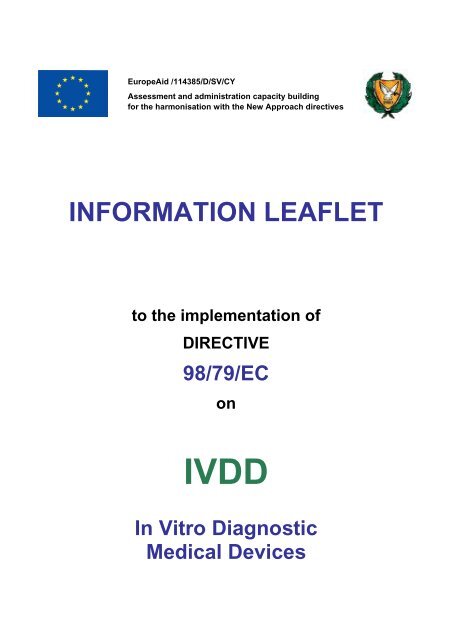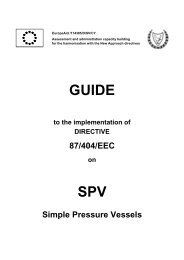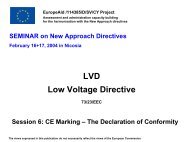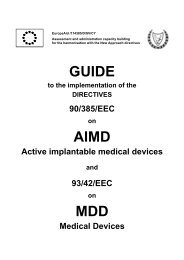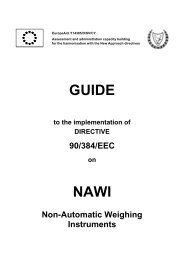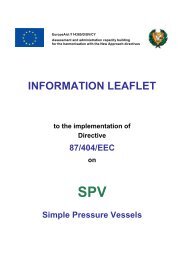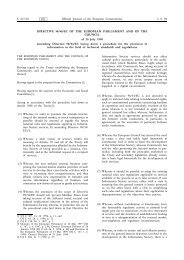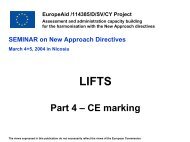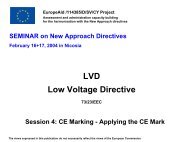INFORMATION LEAFLET
INFORMATION LEAFLET
INFORMATION LEAFLET
Create successful ePaper yourself
Turn your PDF publications into a flip-book with our unique Google optimized e-Paper software.
EuropeAid /114385/D/SV/CYAssessment and administration capacity buildingfor the harmonisation with the New Approach directives<strong>INFORMATION</strong> <strong>LEAFLET</strong>to the implementation ofDIRECTIVE98/79/EConIVDDIn Vitro DiagnosticMedical Devices
Information Leaflet on IVD DirectiveEuropeAid /114385/D/SV/CYINTRODUCTIONThis information is intended as general guidance and should not be regarded as an authoritativestatement of the law. Manufacturers and others should not rely on this information but shouldconsult the legislation referred to, making their own decisions on matters affecting them inconjunction with their lawyers and other professional advisers.What is a medical device?A series of three Directives regulating the safety and marketing of medical devices throughoutthe European Union started to come into effect from 1 January 1993.For the purposes of the Directives, a medical device is defined as:"any instrument, apparatus, appliance material or other article, whether uses alone or incombination, including the software necessary for its proper application intended by themanufacturer to be used on human beings for the purpose of:• diagnosis, prevention, monitoring, treatment or alleviation of disease,• diagnosis, monitoring, treatment, or alleviation of or compensation for an injury orhandicap,• investigation, replacement or modification of the anatomy or of a physiological process,• control of conceptionand which does not achieve its principal intended action in or on the human body bypharmacological, immunological or metabolic means, but which may be assisted in its functionby such means".Why do we need the directives?Before the introduction of the medical devices Directives, each Member State in the EuropeanUnion would control the safety and marketing of medical devices on its territory in different ways.The Directives benefit manufacturers by harmonising controls within a single system and avoidthe need for manufacturers having to comply with 15 (or 25) different sets of rules. Purchasersand users can also be reassured that devices manufactured anywhere in the Union should meetcommon standards of performance and safety.The Directives benefit patients and users, by setting out essential requirements that productsmust meet. These make it clear that devices must not compromise the health or safety of thepatient, user or any other person, and that any risks associated with the device are compatiblewith patient health and protection. Any side effects must be acceptable when weighed againstthe intended performance of a device. Devices meeting these requirements generally carry the"CE" mark to show that they comply.THE DIRECTIVESTHE ACTIVE IMPLANTABLE MEDICAL DEVICES DIRECTIVEThis first Directive covers all powered implants or partial implants that are left in the humanbody. Heart pacemakers are the most common example of powered implants.
Information Leaflet on IVD DirectiveEuropeAid /114385/D/SV/CYTHE MEDICAL DEVICES DIRECTIVEThe second Directive covers most other medical devices, ranging from, for example, first aidbandages, tongue depressors, hip prostheses, X-Ray equipment, ECG and heart valves.THE IN VITRO DIAGNOSTIC MEDICAL DEVICES DIRECTIVEThe third Directive covers any medical device which is a reagent, reagent product, calibrator,control material, kit, instrument, apparatus, equipment or system intended for use in-vitro for theexamination of specimens, including blood and tissue donations, derived from the human body.Examples of in-vitro diagnostic devices are blood grouping reagents, pregnancy test kits andHepatitis B test kits.KEY POINTS IN THE DIRECTIVESCE MARKINGThe CE mark that appears on a medical device or on its packaging means that the devicesatisfies the relevant essential requirements and is fit for its intended purpose as specified bythe manufacturer.Eventually all devices, (except custom-made devices, those intended for clinical investigationsand devices for performance evaluation) whether used in private or public hospitals and nursinghomes or sold in retail outlets, will have to carry the CE marking.CLASSIFICATIONThe Medical Devices Directive and the In Vitro Diagnostic Medical Devices Directive include aclassification system whereby the level of regulatory control applied to devices is proportionateto the degree of risk associated with the device. The strictest controls therefore apply only tohigh-risk products.THE COMPETENT AUTHORITYThe Competent Authority is the body responsible for implementing the requirements of theDirectives in each Member State. The Competent Authority's main role is to ensure thatmanufacturers comply with the Directives, to evaluate adverse incident reports received frommanufacturers, and carry out a pre-clinical assessment of devices intended for clinicalinvestigation.NOTIFIED BODIESThe Competent Authority is also responsible for designating the independent certificationorganisations (Notified Bodies) that check that manufacturers of medium and high risk medicaldevices have followed the requirements. Once they are satisfied, manufacturers may apply theCE mark to their products and place them on the market.
Information Leaflet on IVD DirectiveEuropeAid /114385/D/SV/CYCLINICAL INVESTIGATIONSThe Directives require all devices intended for clinical investigation in the EU to be formallyassessed on the risks such investigations might pose to the health and safety of patients. Formost medical devices (except in-vitro diagnostic devices) manufacturers have to inform therelevant Competent Authority if they intend to start a clinical investigation at least 60 days beforeit is due to begin. The investigation may start after the 60-day period unless the CompetentAuthority notifies the manufacturer of a decision to the contrary on grounds of public health.ADVERSE INCIDENT REPORTING (VIGILANCE)Manufacturers are required to report serious incidents to the Competent Authority. Informationabout these is collected and evaluated centrally and, where necessary, made available to otherMember States. The overall aim of the system is to improve the safety of patients, users andothers by trying to prevent incidents similar to those reported occurring elsewhere in the Union.IN VITRO DIAGNOSTIC MEDICAL DEVICES DIRECTIVEINTRODUCTIONThe In Vitro Diagnostic Medical Devices Directive (98/79/EC) (“the Directive”) was formallyadopted in October 1998 and published in the Official Journal of European Communities on 7December 1998 (ref OJ No. L331 7.12.98 p.1).The Directive introduced for the first time common regulatory requirements dealing specificallywith the safety, quality and performance of in vitro diagnostic medical devices (IVDs), therebybringing them into line with other medical devices. In outline, the Directive is intended to ensurethat IVDs do not compromise the health and safety of patients, users and third parties and attainthe performance levels attributed to them by their manufacturer.The relevant provisions of the Directive came into force on 7 June 2000. However, there was atransitional period until December 2003. From this date IVDs which are placed on the marketmust comply with the Directive. Non-compliant IVDs which have been placed on the market by 7December 2003 must be put into service (i.e. first made available to a final user) by 7 December2005. IVDs which are put into service but not placed on the market have until 7 December 2005to comply with the legislation.SCOPE OF THE DIRECTIVEWhat is an in vitro diagnostic madical device?The Directive defines an IVD as:“any medical device which is a reagent, reagent product, calibrator, control material, kit,instrument, apparatus, equipment, or system, whether used alone or in combination, intendedby the manufacturer to be used in vitro for the examination of specimens, including blood andtissue donations, derived from the human body, solely or principally for the purpose of providinginformation:• concerning a physiological or pathological state, or• concerning a congenital abnormality, or
Information Leaflet on IVD DirectiveEuropeAid /114385/D/SV/CY• to determine the safety and compatibility with potential recipients, or• to monitor therapeutic measures."ACCESSORIES TO IVDS“Accessory” means “an article which, whilst not being an in vitro diagnostic medical device, isintended specifically by its manufacturer to be used together with a device to enable that deviceto be used in accordance with its intended purpose.” (Article 1.2(c)).For the purposes of the Directive accessories are treated as IVDs in their own right.However "invasive sampling devices" or those which are directly applied to the human body forthe purpose of obtaining a specimen, are not considered to be accessories to IVDs.Generally, such devices will be regulated by Directive 93/42/EEC (Medical Devices).IVDS NOT PLACED ON THE MARKETThe conformity assessment procedures apply not only to IVDs which are placed on the market,but also to any person who manufactures IVDs and, without placing them on the market, “putsthem into service and uses them within the context of his professional activity.” (Article 9.13 ofthe Directive). Thus, for example, a person who manufactures an IVD and then uses it toprovide diagnostic services would generally need to comply with the appropriate conformityassessment procedure in respect of that device.TRADE FAIRS ETCIVDs which are not in compliance with the regulatory requirements may be shown at trade fairs,exhibitions, demonstrations, scientific or technical gatherings etc. provided that such devices arenot used on specimens taken from the participants and a visible sign clearly indicates that thedevice cannot be marketed or put into service until it complies with the requirements of theDirective.THE CONFORMITY ASSESSMENT PROCESSOVERVIEWIn general terms, a manufacturer wishing to place his products on the market under thisDirective must:• assign his devices to one of the relevant risk categories defined in the Directive;• ensure that the device meets the "essential requirements" specified in Annex I of theDirective;• follow the appropriate conformity assessment procedure;• if appropriate (depending on the risk category of the device), ensure that an independentcertification body (called a “Notified Body”) is involved in the conformity assessmentprocedure.
Information Leaflet on IVD DirectiveEuropeAid /114385/D/SV/CYMANUFACTURERThe manufacturer is defined in the Directive as:a. the “person with responsibility for the design, manufacture, packaging and labelling of adevice before it is placed on the market under his own name, regardless of whetherthese operations are carried out by that person himself or on his behalf by a third party;”orb. a person who “assembles, packages, processes, fully refurbishes and/or labels one ormore ready made products and/or assigns to them their intended purpose as deviceswith a view to their being placed on the market under his own name.” This does not applyto a person who assembles or adapts devices already on the market to their intendedpurpose for an individual patient.AUTHORISED REPRESENTATIVEManufacturers who do not have a registered place of business in the EC must designate anauthorised representative to perform certain obligations (e.g. to make certain documentationavailable on request) and may designate an authorised representative to perform othersubstantive obligations.Additionally, such a manufacturer must also designate an authorised representative as theperson responsible for marketing the IVD in the EC and for registering that device with theappropriate Competent Authority.ESSENTIAL REQUIREMENTSAnnex I of the Directive lists various "essential requirements" with which IVDs must complybefore being placed on the market/put into service. These aim to ensure that IVDs do notcompromise the health and safety of patients, users, and others, and are designed andmanufactured so that they are suitable for the relevant purpose specified by the manufacturerand achieve the performances stated by the manufacturer. Not all the essential requirements willapply to all devices and it is for the manufacturer of the device to assess which are appropriatefor his particular product. In determining this, account must betaken of the intended purpose ofthe device.LEVEL OF REGULATORY CONTROLThe majority of IVDs do not require the intervention of a notified body in the conformityassessment process. However, for some IVDs (the correct performance of which is perceived tobe essential to health), involvement of a notified body will be required.For the purposes of the conformity assessment procedures, the Directive groups IVDs into fourcategories.THE FOUR CATEGORIESThese categories are, in order of increasing perceived risk:• general IVDs, i.e. all IVDs other than those covered by Annex II and IVDs for self-testing;
Information Leaflet on IVD DirectiveEuropeAid /114385/D/SV/CY• IVDs for self-testing (a device intended by the manufacturer to be able to be used bylay persons in a home environment) excluding self-test devices covered in Annex II;• IVDs in Annex II List B of the Directive: Which, amongst others, includes reagentsproducts for rubella, toxoplasmosis and phenylketonuria as well as devices for selftesting for blood sugar;• IVDs in Annex II List A of the Directive: Which includes reagents and products for HIV Iand II, Hepatitis B, C and D, and reagent products for determining ABO systems andantikell.THE CONFORMITY ASSESSMENT ROUTESIn order to demonstrate compliance with the essential requirements, the manufacturer mustfollow the conformity assessment procedure appropriate for the category of IVD concerned.Conformity assessment routes are detailed in Article 9 of the Directive, which cross-refers to therelevant Annexes. The conformity assessment routes are outlined below.GENERAL IVDsThe manufacturer must declare and ensure that the device meets the provisions of the Directivewhich apply. No notified body involvement is required.SELF-TEST IVDS NOT COVERED IN ANNEX IIThe manufacturer, in addition to complying with the requirements for general IVDs, must, beforea declaration of conformity can be made, lodge an application with a notified body for theexamination of the design of the device. This will include aspects affecting its suitability for nonprofessionalusers. Alternatively the manufacturer may follow the conformity assessment routesfor higher risk products as below.ANNEX II IVDSAll Annex II IVDs require the intervention of a notified body before a declaration of conformitywith the Directive can be made.For Annex II, list B IVDs, the notified body will• either carry out an audit of the full quality assurance system• or carry out type examination plus verification of each batch or product• or carry out type examination plus audit of the production quality assurance system.For Annex II, list A IVDs, the notified body will• either carry out an audit of the full quality assurance system and review the productdesign dossier• or carry out type examination plus audit of the production quality assurance system.In addition, for Annex II list A IVDs, the notified body must verify each product or batch ofproduct before the manufacturer may place them on the market.
Information Leaflet on IVD DirectiveEuropeAid /114385/D/SV/CYFURTHER <strong>INFORMATION</strong>CYPRUS COMPETENT AUTHORITYIn Cyprus the Ministry of Health is responsible for enforcement of the MDD and AIMD relatedregulation. Further details on enforcement and penalties are available at Cyprus Contact point attheMinistry of HealthorContact:Mary Avraamidoumavraamidou@mphs.moh.gov.cyMinistry of HealthContact:Stelios Christofidesmpd.mh@cytanet.com.cyCYPRUS LEGISLATIONGeneral requirements and stipulation are layed down in the Cyprus Framework LawN. 30(I)2002 (published 5.4.2002) and its amendment Framework Law (Amend.) N. 29(I)2003(published 28.3.2003).The Framework Law represents the legal basis for the Cyprus Regulations addressingrespective Directives.The Cyprus Regulation addressing the IVDD (In vitro diagnostic medical devices) directive isimplemented as Regulation P.I. 597/2003 (published 18.7.2003).Furthermore, the MDD directive is Regulation P.I. 598/2003 (published 18.7.2003) and theAIMD directive is Regulation P.I. 599/2003 (published 18.7.2003).FURTHER <strong>INFORMATION</strong>Further information and links to all relevant European websites are available athttp://www.cys.mcit.gov.cyunder the button named:NEW APPROACHThis Leaflet was printed with funds of the EuropeAid /114385/D/SV/CY project:“Assessment and administration capacity building for the harmonisation with the New Approachdirectives”The views expressed in this publication do not necessarily reflect the views of the EuropeanCommission or the Cyprus Ministry of Commerce, Industry and Tourism.© Cyprus Ministry of Commerce, Industry and Tourism, Nicosia, May 2004


